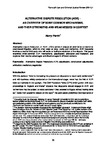Alternative Dispute Resolution (ADR): An Overview of Some Common Mechanisms, and their Strengths and Weaknesses in Context
| dc.contributor.author | Perrin, Harry | |
| dc.date.accessioned | 2017-03-29T10:38:27Z | |
| dc.date.accessioned | 2017-04-11T11:30:21Z | |
| dc.date.available | 2017-03-29T10:38:27Z | |
| dc.date.available | 2017-04-11T11:30:21Z | |
| dc.date.issued | 2014 | |
| dc.identifier.citation |
Perrin, H. (2014) 'Alternative Dispute Resolution (ADR): An Overview of Some Common Mechanisms, and their Strengths and Weaknesses in Context', Plymouth Law and Criminal Justice Review, 6, pp. 70-79. Available at: https://pearl.plymouth.ac.uk/handle/10026.1/9006 | en_US |
| dc.identifier.issn | 2054-149X | |
| dc.identifier.uri | http://hdl.handle.net/10026.1/9006 | |
| dc.description.abstract |
Alternative Dispute Resolution, or ’ADR’, offers parties in dispute an alternative to traditional court-based litigation, which is often seen as slow, costly and ineffective. ADR frequently involves a neutral third party who will settle or facilitate resolution of the dispute. This paper examines three common ADR mechanisms, adjudication, arbitration and mediation, and.explores their relative advantages and disadvantages in different contexts. | en_US |
| dc.language.iso | en | en_US |
| dc.publisher | University of Plymouth | |
| dc.rights | Attribution 4.0 International (CC BY 4.0) | * |
| dc.rights.uri | https://creativecommons.org/licenses/by/4.0/ | * |
| dc.subject | Alternative Dispute Resolution | en_US |
| dc.subject | ADR | en_US |
| dc.subject | adjudication | en_US |
| dc.subject | construction adjudication | en_US |
| dc.subject | arbitration | en_US |
| dc.subject | mediation | en_US |
| dc.subject | negotiation | en_US |
| dc.title | Alternative Dispute Resolution (ADR): An Overview of Some Common Mechanisms, and their Strengths and Weaknesses in Context | en_US |
| dc.type | Article | en_US |
| dc.type | Article | |
| plymouth.volume | 6 | |
| plymouth.journal | The Plymouth Law & Criminal Justice Review |



